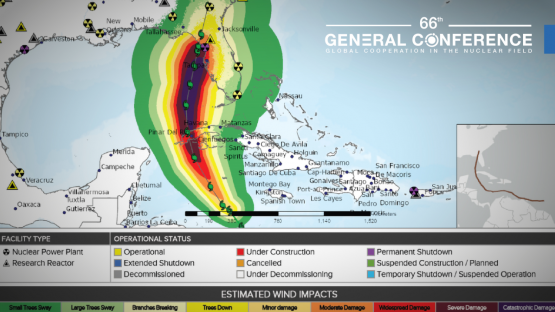Natural hazards and disasters, such as earthquakes, floods or wildfires may seriously challenge nuclear installation safety. Therefore, it is crucial not only to predict such events and calculate their magnitude, but also effectively assess the potential impact on the safety of nuclear installations to utilize appropriate response mechanisms in time. To this end, the IAEA has launched the External Events Notification System (EENS) unveiled at an event on the sidelines of the IAEA’s 66th General Conference today.
EENS is a web-based tool that provides real time information on external events and hazards, such as earthquakes, tsunamis, volcano eruptions, river and coastal flooding, rotational winds and wildfires, that have occurred or are expected to occur, including on their severity and location, as well as estimations of their potential effects on nuclear installations and major population centres. The system collects relevant data and sends it directly to the IAEA’s Incident and Emergency Centre (IEC) and External Event Safety Section (EESS) for assessment.
During the event, Head of the External Events Section at the IAEA Paolo Contri and Senior Safety Officer Ayhan Altinyollar showcased how the EENS works in practice, while IEC Response System Officer Günther Winkler explained the role it plays both within the Centre’s specific work and global nuclear safety and security more broadly. “The EENS is designed to provide initial assessments of the severity of external events on nuclear facilities, which can lead to activations of the IAEA’s Incident and Emergency Centre,” said Winkler. “This tool will help us to promptly identify natural hazards that can affect nuclear or radiation safety in order to exchange information or to coordinate international assistance between Member States.” The event was concluded with a round table, with the participants discussing the data sources for EENS, the on-call process of the IEC and issues of cybersecurity.
The EENS is based on a multi-hazard monitoring and early warning platform and has been developed in collaboration with the University of Hawaii’s Pacific Disaster Center (PDC) and Tenefit, a supplier of risk and impact intelligence to enterprises. “It is a system that will be permanently available to provide 24/7 support to the IAEA, forming a database which can be used for further assessments,” said Deputy Executive Director at PDC Chris Chiesa during the event. The customized version, tailored to the needs of the IAEA, has been modified to focus specifically on the impact of hazards on nuclear installations. It consists of two components: the Alert System (AS) and the External Event Damage Forecast (EEDF).
Monitoring and analyzing threats in real time
The Alert System monitors – in real time – situations in the vicinity of nuclear installations, and is based on carefully selected indicators, which determine the severity of the event. It alerts the IAEA’s Incident and Emergency Centre when hazards could potentially affect nuclear sites.
The External Event Damage Forecast receives information from the Alert System and produces a preliminary estimation of potential damage to nuclear installations and population centres. This estimation is called an Event Notification Report (ENR), which consists of the basic information about the event, such as magnitude, timing and location, as well as impact projections. This report is essential for evaluation of the lessons learnt from recent external events and for assessment of the robustness of nuclear installations, for periodical dissemination to all Member States.
“In case of a cyclone, for example, the ENR would include the basic information on the cyclone with maps, expected storm surge at coastal sites, the possible arrival time and the estimated wind speed at nuclear installation sites. This information is vital for the IEC to be able to swiftly offer its assistance to support an affected country,” explained Contri. “The EENS allows us to monitor the global natural hazard situation in the vicinity of all nuclear installations, not just the nuclear power plants, including large cities where radioactive sources may be affected by the hazard. This system is an integral part of IAEA’s work, allowing us to evaluate the situation and help countries mitigate the associated risks. In the years to come, the severity of natural hazards is expected to increase because of climate change. We must be prepared for this.”
The EENS launch includes its first two modules – focusing on earthquakes and cyclones prognosis. An additional four modules on river floods, tsunamis, volcano eruptions and wildfires are under development and are expected to be operational by mid-2023.
The development of the system has been financially supported by France, Japan and the United States.




